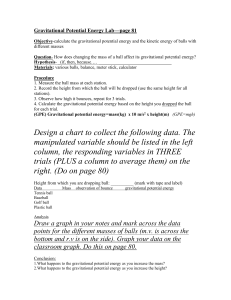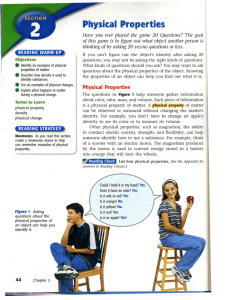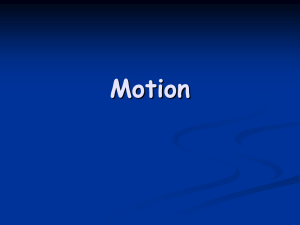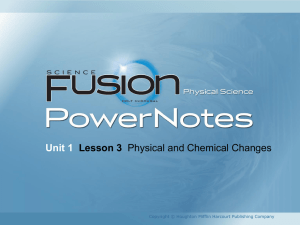Chapter 1 Properties of Matter ppt
advertisement
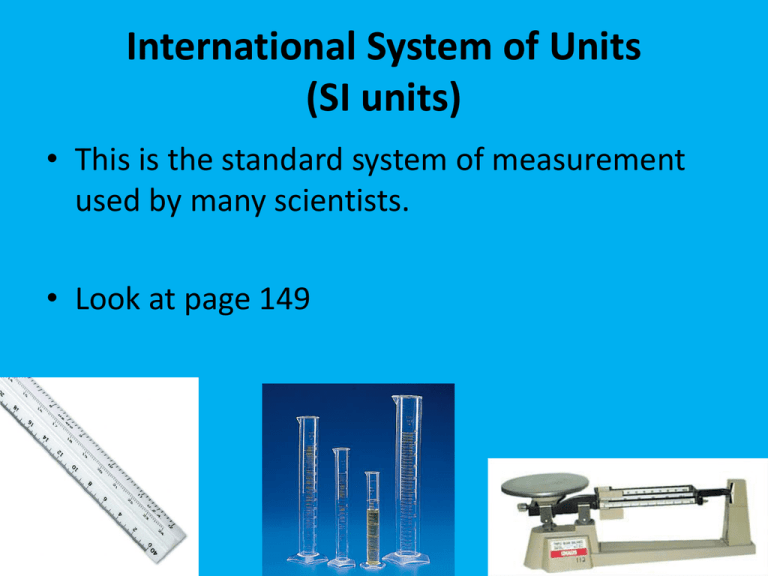
International System of Units (SI units) • This is the standard system of measurement used by many scientists. • Look at page 149 Introduction The Properties of Matter matter-is anything that has mass and takes up________. The Properties of Matter • Matter is not just something you can see and touch. Invisible gases are also forms of matter that have physical and chemical properties. • Matter is anything that has mass & volume . Even though we cannot usually see gases in the atmosphere, we are able to feel wind and see its effects. • What do you have in common with a table, a glass of water, and a neon sign? – Matter cannot share the same space at the same time with something else. Look at figure 1 on page 4 Volume• The amount of space taken up by an object. Demonstration (pg. 4) • • • • • Rock Paper Clip Book Pencil Cardboard Box • How are these objects alike? • They all take up space. This is volume. Measuring the Volume of Liquids • You will use a graduated cylinder to measure the volume of liquids. Meniscus meniscus-the curve at a liquid’s surface by which one measures the volume of the liquid To measure the volume of most liquids, look at the bottom of the meniscus (look at pg. 5) Liquid Volume • Liters (L) and milliliters (mL) are the units used most often to express the volume of liquids. Group Volume Activity • Page 5 • Quick Lab Volume of a Regularly Shaped Object • The volume of any solid object is expressed in cubic units. • cubic- “having three dimensions” • m³ (cubic meters) and cm³ (cubic centimeters) are the most often used to express the volume of a solid. Formula to find the volume of regularly shaped objects • To find the volume of a cube or a rectangular object: volume =length x width x height Look at page 6 • Review of triple beam balance, reading the meniscus, and measuring volume of a regular shaped object, Volume of an Irregularly Shaped Solid Object • You have to find the volume of the water that the object displaces. • The volume of the water displaced by the object is equal to its volume. Steps to measure the volume: 1. Fill the graduated cylinder with a designated amount of water and record 2. Add the object, then record the water level again. 3. Subtract this from the original water level. 4. This is your volume. Mass-is the amount of matter in an object • The only way to change the mass of an object is to change the amount of matter that makes up the object. • You and a peanut are both matter, but you are made of more matter than a peanut, so you have more mass. What is the difference between mass and weight? • weight-is a measure of the gravitational force exerted on an object • The more mass an object has, the greater the gravitational force on the object. • An objects weight can change depending on its location in the universe. • An object would weigh less on the moon and more on the earth because the moon has less gravitational force. What is the difference between weight and mass? Mass • It is a measure of the amount of matter in an object • It is always constant no matter where you are in the universe. • Mass is measured by using a balance. • Mass is expressed in grams (kg, mg, or g) Weight • It is a measure of the gravitational force on an object. • Weight varies depending on where the object is in relation to the earth. • Weight is measured by using a spring scale. • Weight is expressed in newtons (N) Ohaus Triple-Beam Balance Tutorial • Ohaus Triple-beam balance Tutorial Look at page 8 • There are 2 blocks: one sponge and one brick – The brick has more mass, so a greater gravitational force is exerted on it. Therefore, it weighs more. – Weight is a good estimate of the mass of an object on Earth because gravity does not change on Earth. Using this information see if you can Calculate the Math Focus Problems • 1 Newton is = 100 grams on Earth Math Focus (page 8) 1. A student has a mass of 45,000 g. How much does this student weigh in newtons? 45,000g 100g = 450 g 2. What is the weight of a car that has a mass of 1,362,000g? 1,362,000g 100g = =13,620g Your pair of boots has a mass of 850g. If each boot has exactly the same mass, what is the weight of each boot? 850g 2g = 425g 425g 100g = 4.25g Inertia-It is the tendency of an object to resist a change in motion. • An object will remain at rest until something causes the object to move. • An object will keep moving at the same speed and in the same direction unless something acts on the object to change its speed or direction. • The heavier something is, the more resistance there will be to move it. • For example, playing kick ball with a bowling ball would be very difficult to get the ball moving (and painful). Mass is a measure of inertia. • An object that has a large mass is harder to get moving and harder to stop than an object with less mass. • For example, pushing a grocery cart with a potato in it is easy (small mass), but pushing a cart filled with potatoes is more difficult to start and stop. Section 2: Physical Properties • physical property-can be observed or measured without changing the matter’s identity. • Physical properties: • • • • • • • • • • • Magnetism Thermal conductivity Color Volume Strength State Density Malleability Ductility Solubility Flexibility 20 questions Density • Is the amount of matter in a given space(volume). A golf ball and a table tennis ball(ping pong ball) have similar volumes, but one has more mass. So, the greater mass has more density. Liquid Layers • The order of the layers shows the order of increasing density. • The densest layer is on the bottom. Density of Solids • Which would you rather carry around all day: a kilogram of lead of a kilogram of feathers? • Both have the same mass, but the feathers would take up much more volume(space). • Knowing the density of a substance can tell you if it will float or sink in water. • If the density of an object is less than the density of water, the object will float. • If it is more than the density of water, it will sink. Solving for Density • To find density: • 1. Measure an object’s mass • 2. Measure the object’s volume D= m v Units are: g/cm³, g/mL³, kg/m³, and kg/L Using Density to Identify Substances • It is a useful physical property for identifying substances. • Each substance has a density that differs from the densities of other substances. • The density of a substance is always the same at a given temperature and pressure. • Look at Table 1 on page 13 Math Focus on Page 13 • What is the density of an object whose mass is 25g and whose volume is 10cm³? • 1. Find the density of a substance that has a mass of 45 kg and a volume of 43 m³. Be sure to use the correct units for density. • 2. Suppose you have a lead ball whose mass is 454g. What is the ball’s volume? – Use table 1 on page 13. • What is the mass of a 15 mL sample of mercury? Physical Changes do not form new substances • physical change-a change that affects one or more physical properties of a substance. • Examples of physical changes: • • • • • • • Pounding a piece of silver into a heart A popsicle melting(all changes of state are physical) Smashing an aluminum can Freezing water Sanding a piece of wood Dissolving sugar in water Melt butter Matter and Physical Changes • A physical change does not change the identity of the matter Chemical Properties • They describe matter based on its ability to change into new matter that has different properties. Types of Chemical Properties • A substance has these properties even when it is not burning or reacting. • Flammability-ability of a substance to burn • Reactivity-ability of two or more substances to combine and form one or more new substances (look at figure 1 on page 16). • Look at figure 2 on page 17 • Physical vs. Chemical Property Chemical Change • This happens when one or more substances are changed into new substances that have new and different properties. • Chemical changes and chemical properties are not the same. • How are they different? • Chemical changes is the process where the substances actually change into new substance. • Chemical properties describe matter based on it’s ability to change into new matter with different properties. Examples of Chemical Changes • Look at page 18 • • • • • • • Hot gas Soured milk Effervescent tablets Statue of liberty Digestion of food Using a battery Baking a cake (figure 4) Signs of Chemical Change • • • • • • • Odor Color change Heat Fizzing Foaming Sound Light • Chemical changes change the identity of the matter involved. • These are difficult to reverse. • Some chemical changes can be reversed (not many). One example is: – Using an electric current to split water into hydrogen and oxygen. Can physical and chemical changes be reversed? • Most physical changes are easily reversed. • Most chemical changes are not easily reversed. – For example, fireworks • The most important question to ask when deciding whether a physical or chemical change has happened is: • “Did the composition change?” composition-is the type of matter that makes up the object and the way that the matter is arranged in the object Look at figure 5 on page 20 • Physical changes do not change the composition of a substance. • For example, water can be a liquid, solid, or gas, but it’s composition is the same. • A chemical change is: • electrolysis-a process where water is broken down into hydrogen and oxygen gases. Statue of Liberty Today Original Statue of Liberty What happened to the Statue of Liberty? substance Substance Mixed with water Mixed with vinegar Mixed with iodine solution Change Change Change Property Baking powder Baking soda Cornstarch Sugar Table 2: Changes and Properties Table 2: Changes and Properties Property Property
